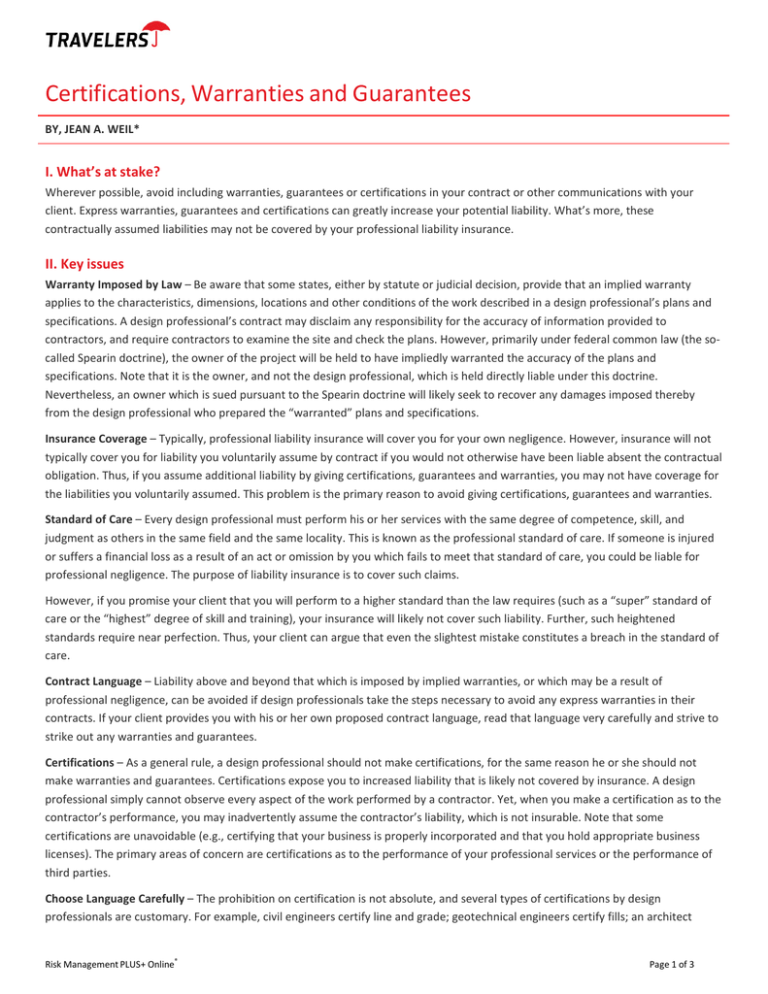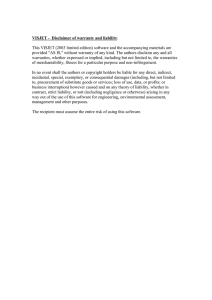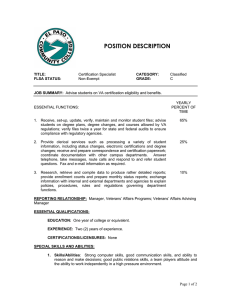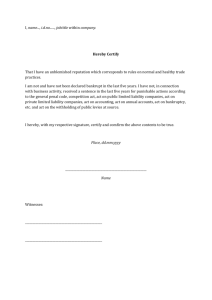
Certifications, Warranties and Guarantees
BY, JEAN A. WEIL*
I. What’s at stake?
Wherever possible, avoid including warranties, guarantees or certifications in your contract or other communications with your
client. Express warranties, guarantees and certifications can greatly increase your potential liability. What’s more, these
contractually assumed liabilities may not be covered by your professional liability insurance.
II. Key issues
Warranty Imposed by Law – Be aware that some states, either by statute or judicial decision, provide that an implied warranty
applies to the characteristics, dimensions, locations and other conditions of the work described in a design professional’s plans and
specifications. A design professional’s contract may disclaim any responsibility for the accuracy of information provided to
contractors, and require contractors to examine the site and check the plans. However, primarily under federal common law (the so‐
called Spearin doctrine), the owner of the project will be held to have impliedly warranted the accuracy of the plans and
specifications. Note that it is the owner, and not the design professional, which is held directly liable under this doctrine.
Nevertheless, an owner which is sued pursuant to the Spearin doctrine will likely seek to recover any damages imposed thereby
from the design professional who prepared the “warranted” plans and specifications.
Insurance Coverage – Typically, professional liability insurance will cover you for your own negligence. However, insurance will not
typically cover you for liability you voluntarily assume by contract if you would not otherwise have been liable absent the contractual
obligation. Thus, if you assume additional liability by giving certifications, guarantees and warranties, you may not have coverage for
the liabilities you voluntarily assumed. This problem is the primary reason to avoid giving certifications, guarantees and warranties.
Standard of Care – Every design professional must perform his or her services with the same degree of competence, skill, and
judgment as others in the same field and the same locality. This is known as the professional standard of care. If someone is injured
or suffers a financial loss as a result of an act or omission by you which fails to meet that standard of care, you could be liable for
professional negligence. The purpose of liability insurance is to cover such claims.
However, if you promise your client that you will perform to a higher standard than the law requires (such as a “super” standard of
care or the “highest” degree of skill and training), your insurance will likely not cover such liability. Further, such heightened
standards require near perfection. Thus, your client can argue that even the slightest mistake constitutes a breach in the standard of
care.
Contract Language – Liability above and beyond that which is imposed by implied warranties, or which may be a result of
professional negligence, can be avoided if design professionals take the steps necessary to avoid any express warranties in their
contracts. If your client provides you with his or her own proposed contract language, read that language very carefully and strive to
strike out any warranties and guarantees.
Certifications – As a general rule, a design professional should not make certifications, for the same reason he or she should not
make warranties and guarantees. Certifications expose you to increased liability that is likely not covered by insurance. A design
professional simply cannot observe every aspect of the work performed by a contractor. Yet, when you make a certification as to the
contractor’s performance, you may inadvertently assume the contractor’s liability, which is not insurable. Note that some
certifications are unavoidable (e.g., certifying that your business is properly incorporated and that you hold appropriate business
licenses). The primary areas of concern are certifications as to the performance of your professional services or the performance of
third parties.
Choose Language Carefully – The prohibition on certification is not absolute, and several types of certifications by design
professionals are customary. For example, civil engineers certify line and grade; geotechnical engineers certify fills; an architect
Risk Management PLUS+ Online®
Page 1 of 3
certifies a pay application. However, if you make such certifications, be careful not to certify beyond what you know is factual,
and do not phrase your certification in absolute terms. Avoid terms such as, “I certify,” “I assure,” and “constructed in strict
conformance.” Rather, use terms such as “to the best of my knowledge, information and belief,” “in my professional opinion”
and “constructed in general conformance.” Any certifications you sign that go above and beyond your knowledge of factual
conditions may raise the standard of care for which you may be held liable. Worse, a court may find that you have assumed part
or all of the liability of the contractor whose work you certified.
No Legal Opinions – You may be asked to certify that a structure was designed or constructed in conformance with all applicable
laws, codes and ordinances. Doing so would constitute a legal opinion you are not qualified to offer. It is entirely beyond the
scope of your services to be familiar with “all” laws that might govern a project. Further, projects are often governed by the laws
of many jurisdictions, some of which may be in conflict.
Other Consequences –Lawsuits based upon a breach of contract or a breach of warranty are usually subject to a longer statute of
limitations than lawsuits based solely upon negligence. Further, if you have a written contract with an express warranty, it is
typically easier for your client to prove that you breached your written promises than that you were negligent.
Other Written Materials – A contract is not the only type of document in which you might create a warranty or guarantee. You
may give a potential client a marketing brochure promoting your business, or you may send your client a cover letter along with a
proposal for services. Review such documents very carefully to ensure they do not contain representations or promises about
your services or abilities that could create an expectation on the part of your client that exceeds the standard of care. The
language in your marketing materials can just as easily be held to be a certification, warranty or guaranty as the language in your
client contract.
III. Negotiating points
Explain the Reasons – Contractors’ contracts typically include all manner of warranties and guarantees concerning their work.
Your client may be accustomed to using the same type of contract for both contractors and design professionals, not being aware
of the ways in which the legal system and insurers differentiate between the two. Contractors provide a product (the building or a
portion thereof) and typically guarantee or warrant their product. However, design professionals provide professional services
pursuant to a standard of care. This is a significant distinction, as design professionals seldom, if ever, have control over the end
product and therefore cannot guarantee or warrant their work.
Explain to your client that any certification, warranty or guarantee you might provide is not covered under your professional
liability policy. If your client is unwilling to be flexible, even upon learning of such a major financial risk to you, consider whether a
business relationship with such a client is truly desirable.
Take it Out – At the outset of contract negotiations, you should simply ask your client to remove any language in his or her
contract with you that says that you will warrant, guarantee or certify any aspect of your services or the work of others.
Protect Yourself – Even if your client is willing to delete all contractual warranties, guarantees or certifications, a client’s attitude
can change during the course of a project. If possible, negotiate a provision that will preclude your client (or anyone else) from
obligating you to warrant, guaranty or certify any aspect of the project at any time. Alternatively, the provision could state that
you may not be compelled to take any action which, in your sole judgment, could place your insurance coverage at risk.
Define Key Terms – If your client insists on a customary and reasonable certification, be sure to carefully define terms such as
“assurance,” “declaration” or “certification.” Explicitly state that none of these words in the contract shall create a warranty or
guaranty of any type. Also, explicitly state that those words, as used in the contract, shall mean an expression of your
professional opinion based upon facts that have been made known to you.
Risk Management PLUS+ Online®
Page 2 of 3
IV. Risk transfer considerations
The following is a sample disclaimer clause regarding certifications, warranties and guarantees:
If the Owner requests the Consultant to execute certificates, the proposed language of such certificates shall be submitted to the
Consultant for review at least ten (10) days prior to the requested dates of execution. The Consultant shall not be required to
execute certificates that would require knowledge, services or responsibilities beyond the scope of this Agreement. Consultant
shall not be required to sign any documents, no matter by whom requested, that would result in Consultant's having to certify,
guarantee or warrant the existence of conditions whose existence Consultant cannot ascertain. As used herein, the words/terms
“certify” or “certificate” shall mean an expression of Consultant's professional opinion to the best of its information, knowledge
and belief, and does not constitute a warranty or guarantee by Consultant. Consultant makes no warranty, express or implied, as
to its professional services.
* Jean A. Weil is a partner at Weil & Drage, APC. Jean has authored several other risk management pieces concerning construction
law and contract negotiation. Jean is a member of the California, Colorodo and Nevada State Bar Associations.
travelers.com/1stchoice
Travelers Casualty and Surety Company of America and its property casualty affiliates. One Tower Square, Hartford, CT 06183
The views expressed in this article are those of the author and do not necessarily reflect the views of The Travelers Companies, Inc. or any of its
subsidiary insurance companies (“Travelers”). This paper is for general informational purposes only. None of it constitutes legal advice, nor is it
intended to create any attorney‐client relationship between you and the author. You should not act or rely on this information concerning the
meaning, interpretation, or effect of particular contractual language or the resolution of any particular demand, claim, or suit without seeking the
advice of your own attorney.
© 2013 The Travelers Indemnity Company. All rights reserved. Travelers and the Travelers Umbrella logo are registered trademarks of the Travelers Indemnity
Company in the U.S. and other countries. Ed. 11‐13
Risk Management PLUS+ Online®
Page 3 of 3





